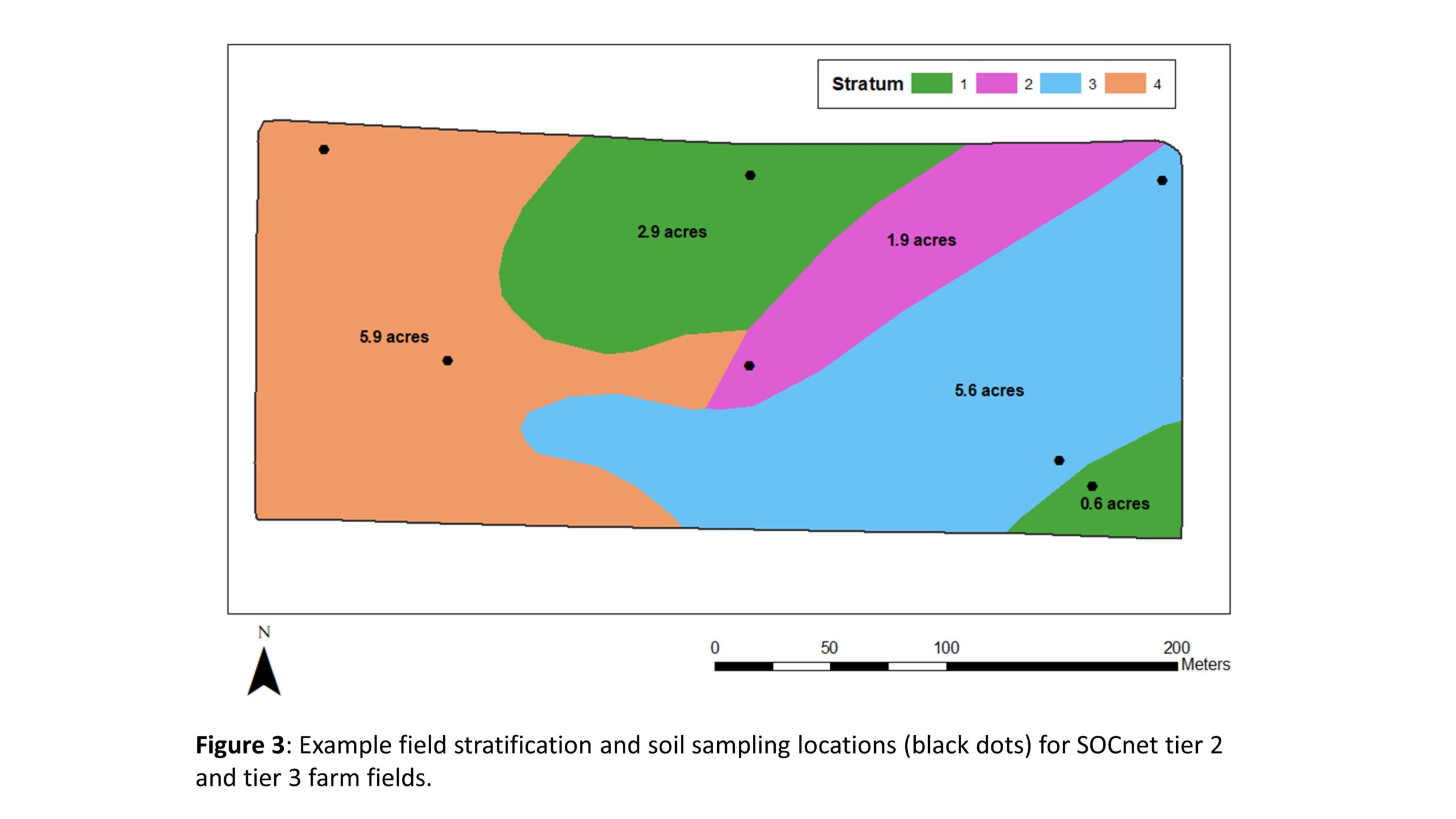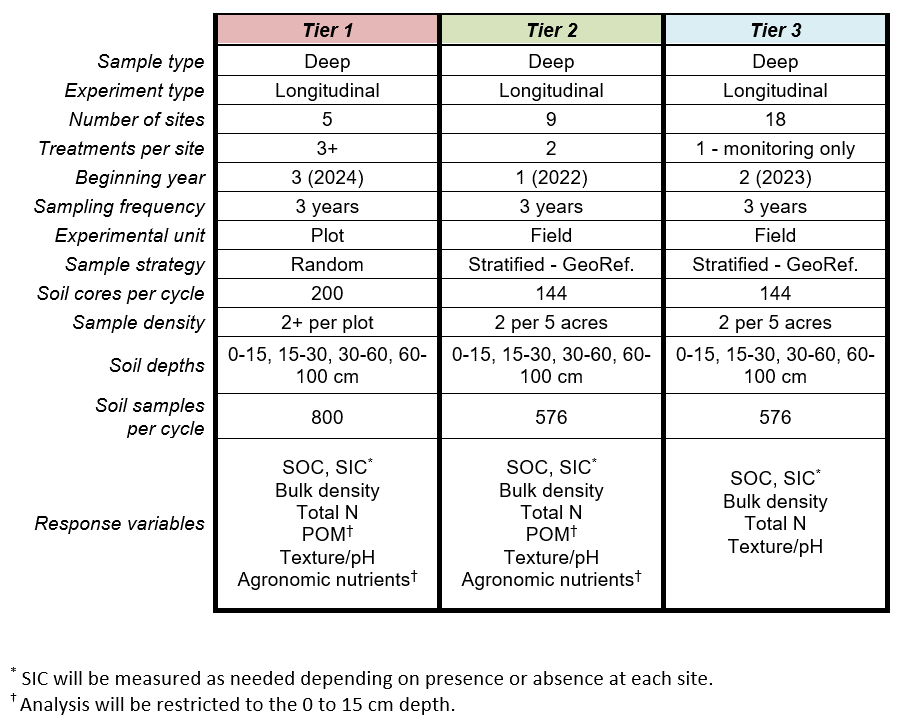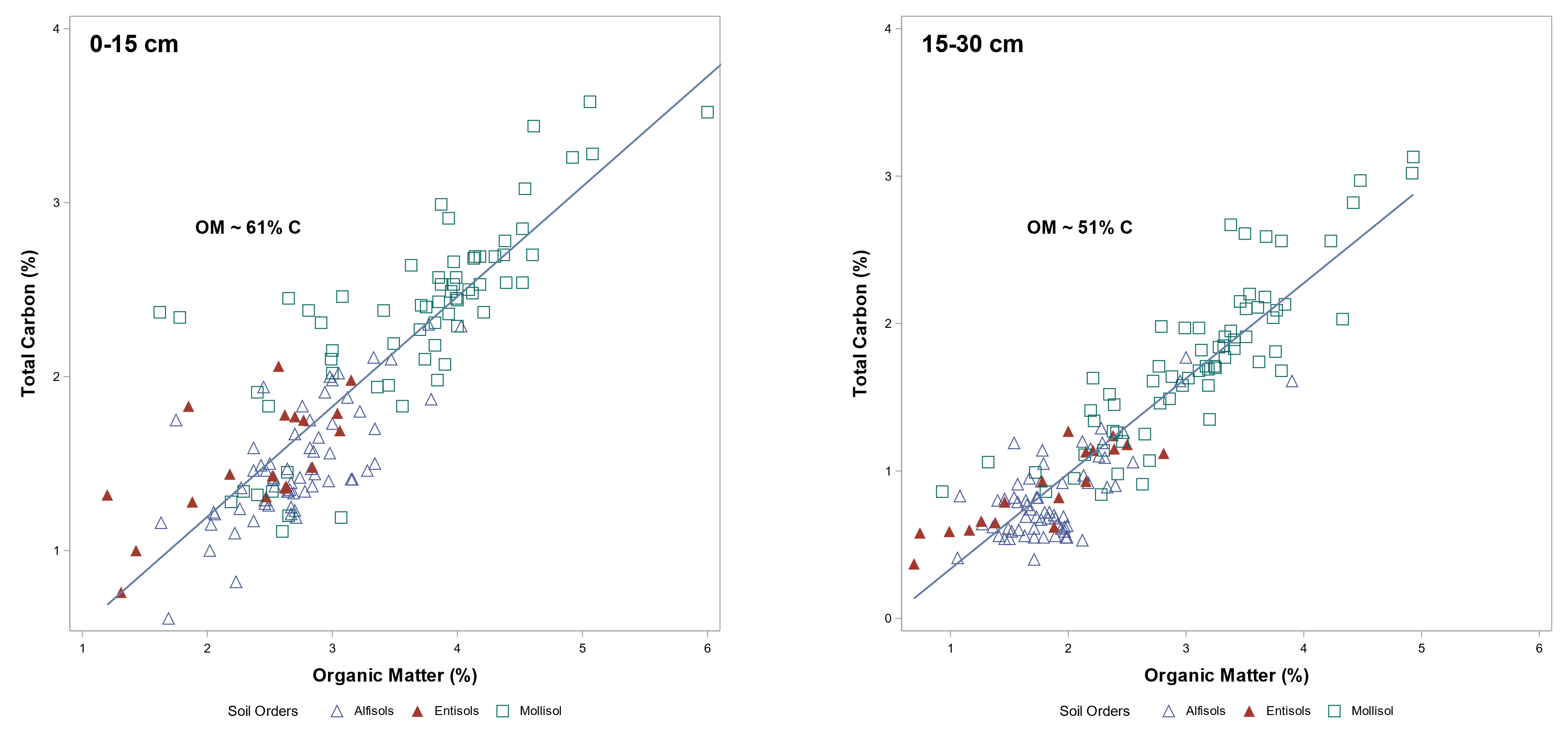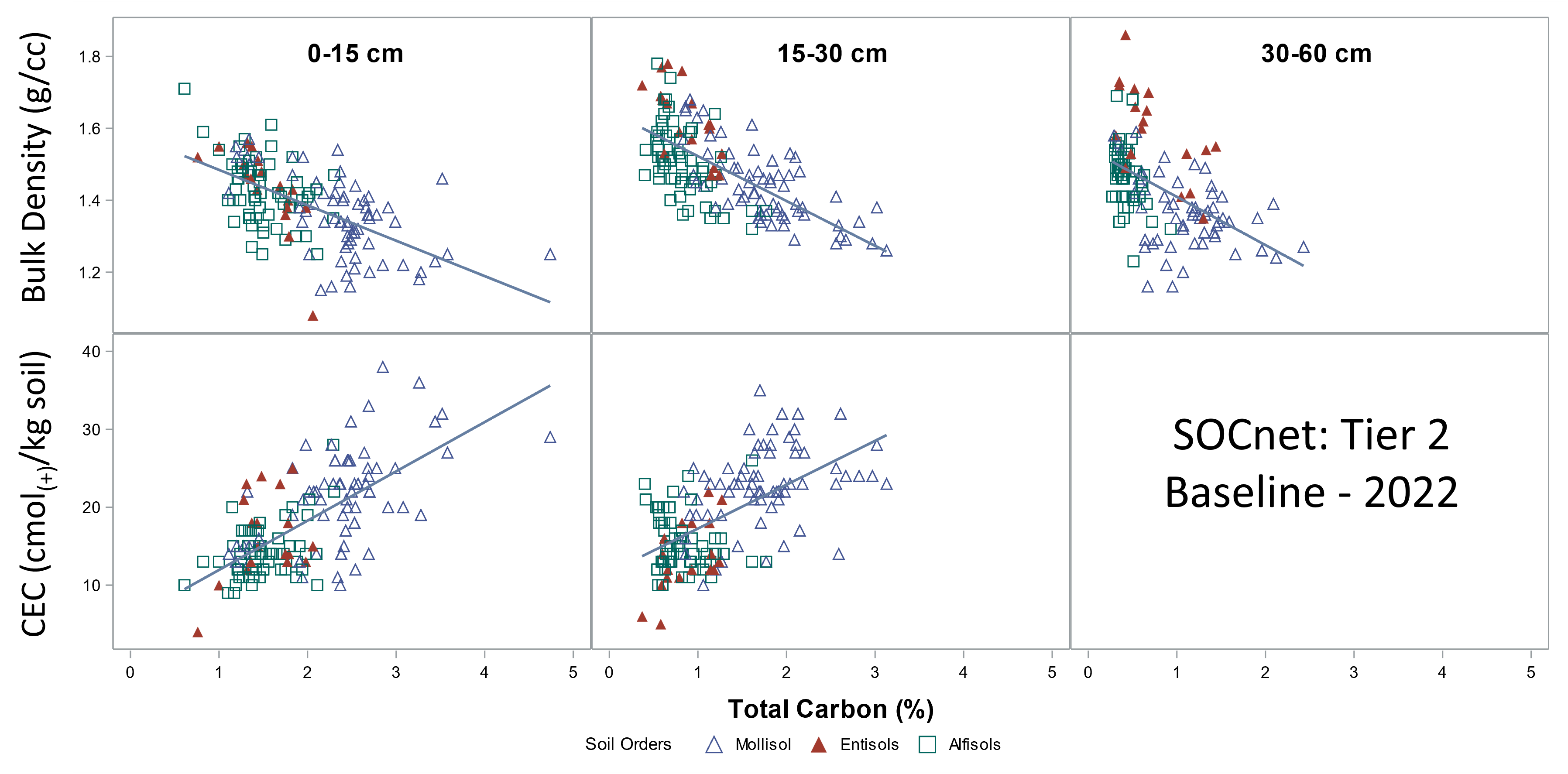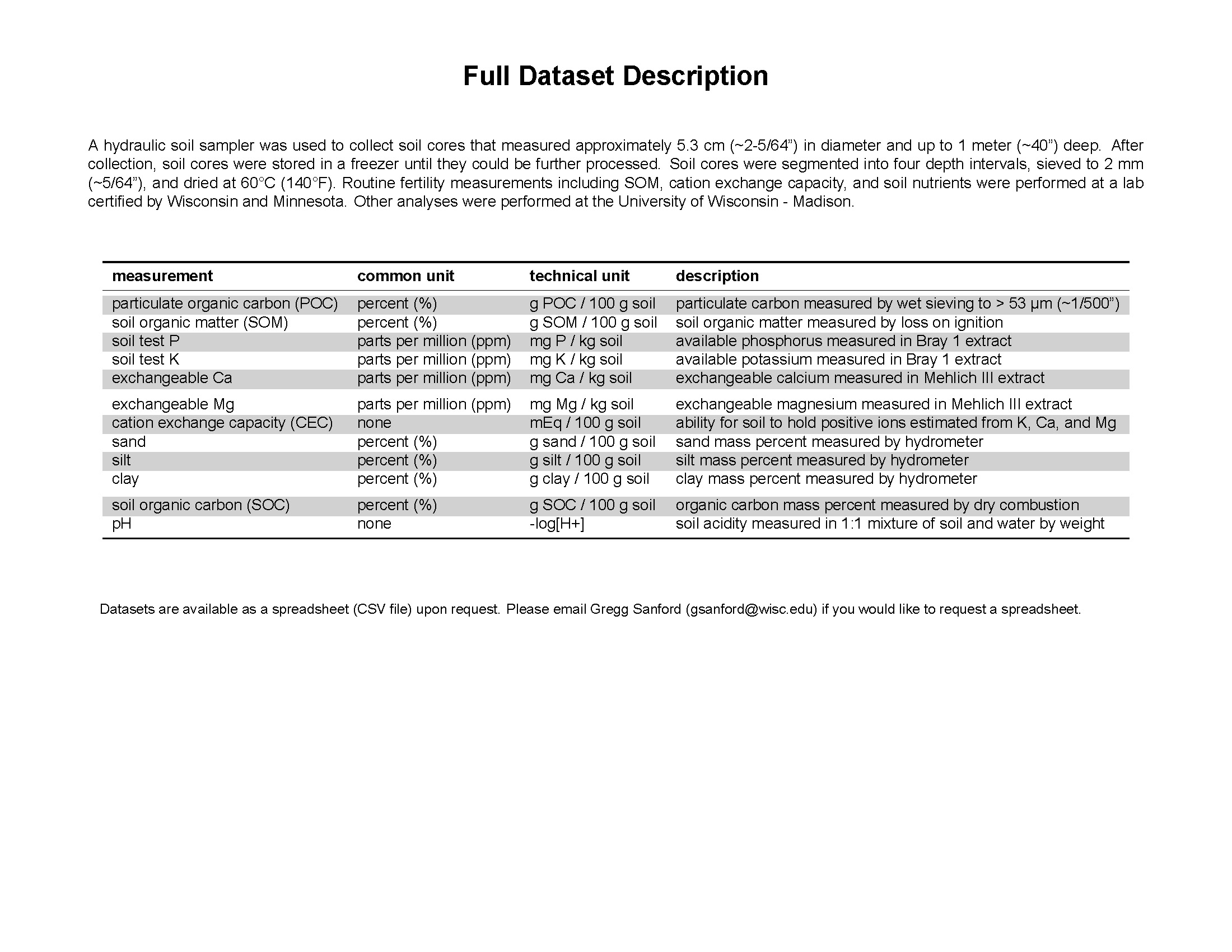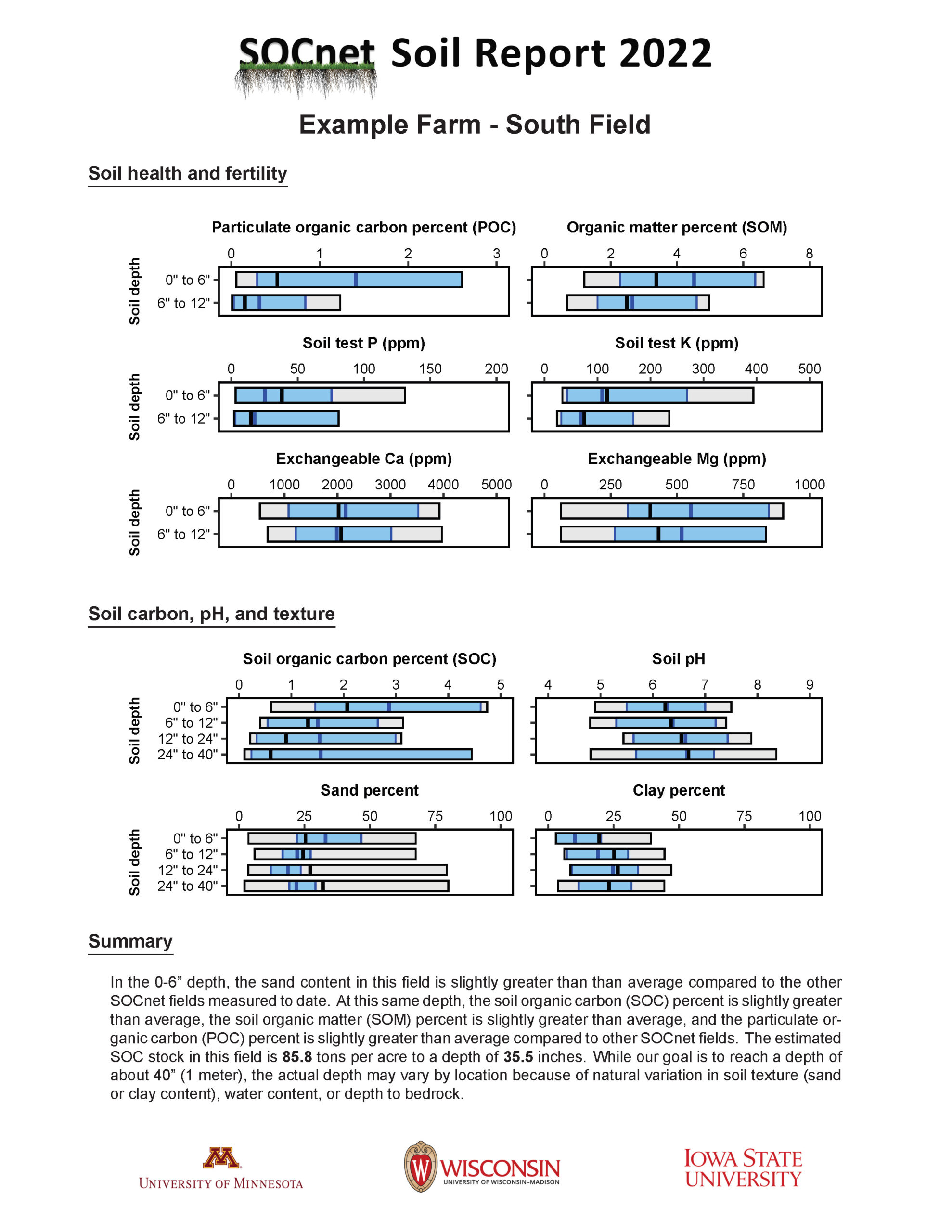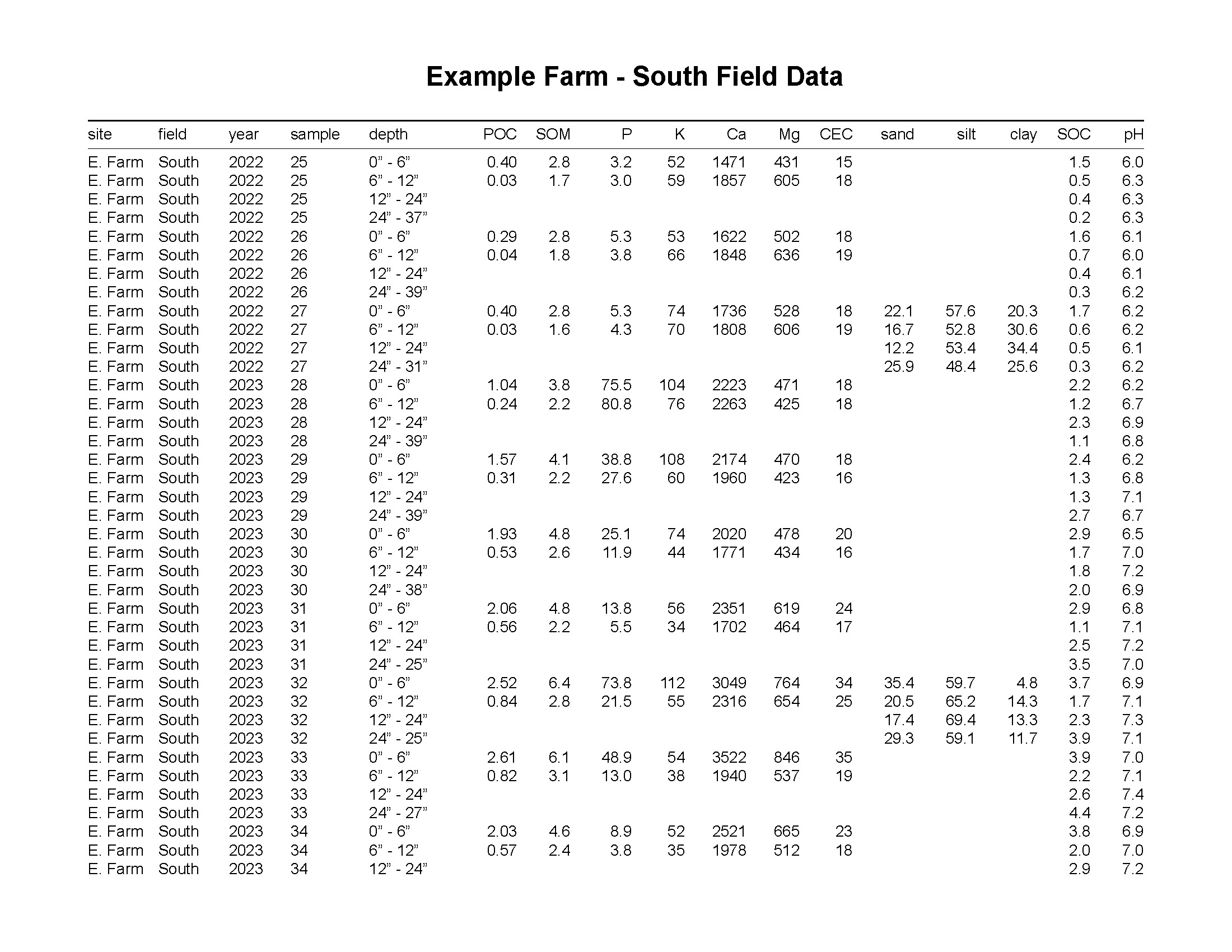Progress report for LNC22-475
Project Information
Soil organic carbon (SOC) is the foundation of productive, profitable, and sustainable farming systems. As SOC accumulates, soil structure and water-holding capacity improve, nutrient retention and mineralization increase, and soils are protected from the devastating effects of erosion1. What’s more, unpredictable and extreme weather puts significant pressure on farmers to produce food and feed for a growing population while simultaneously dealing with fluctuating yields, erratic markets, and unreliable income. Building soil organic carbon (SOC) provides a buffer to these extreme events and contributes to on-farm resilience2. Public and private efforts are constructing markets to compensate farmers for soil carbon sequestration, but accurate assessment is critical to de-risking these efforts. Short-term assessments of surface soils and the use of space as a surrogate for time dominate most efforts to track soil carbon, but these approaches lack the scientific rigor required to assess SOC accrual or loss. Carbon sequestration is a slow and variable process that requires long-term monitoring of entire soil profiles while accounting for potential alterations to bulk density to accurately track change. The Soil Organic Carbon network (SOCnet), a farmer-scientist collaboration, will help build on-farm resilience and prepare farmers to engage in emerging carbon markets by evaluating farming practices designed to build SOC and accurately tracking their effectiveness. SOCnet puts control in the hands of farmers rather than the private sector and will set the standard for accurate accounting of soil carbon credits. SOCnet will link producer-driven on-farm research throughout the North Central US with long-term cropping systems experiments in Wisconsin, Iowa, and Minnesota. These long-term experiments play a critical role in understanding SOC sequestration in the prairie-derived soils of the US Corn Belt. However, because SOC dynamics are strongly influenced by soil and climate factors, multi-location assessment is needed, and on-farm collaborative experimentation is ideal for addressing this limitation. SOCnet will focus on farmer-to-farmer knowledge transfer through state and regional field days and regular network meetings, fostering growth over time. SOCnet will empower farmers by creating tools to track, interpret, and document on-farm carbon stocks to meet their soil health goals, build resilience, and prepare for carbon market opportunities. The knowledge generated through SOCnet will further inform state and local government planning and policy development throughout the North Central US.
- Evaluate the carbon sequestration potential of alternative farming through long-term monitoring of SOC stocks on-farm and Long-term experiments throughout the North Central Region.
- Address major discrepancies in SOC projections from surface-soil estimates, and space-for-time experiments, with longitudinal deep carbon data collected by SOCnet.
- Position farmers to reach their soil health objectives, participate in market opportunities, and maintain ownership of the C sequestration narrative, by developing the tools needed to track, interpret, and document on-farm carbon stocks.
This work will help farmers realize new income opportunities and verify the climate mitigation potential of working lands.
The Soil Organic Carbon Network (SOCnet) is a farmer-scientist collaboration monitoring long-term effects of farming practices on soil carbon (SOC) and other soil health metrics in the Upper Midwest. SOCnet is a network for accurately monitoring SOC change and helping farmers evaluate carbon-market opportunities. SOCnet links producer-driven on-farm research with long-term cropping systems experiments in Wisconsin, Iowa, and Minnesota, that serve as “hubs” for the network and play a critical role in our understanding of SOC change. On-farm sites complement long-term experiments providing essential information about how “real world” farming and environmental variation affect SOC dynamics.
Why SOCnet?
Many farming practices are promoted for their ability to improve soil health and sequester carbon (think cover crops, no-till, and manure addition). Both the private and public sectors are seeking ways to incentivize and reward farmers for carbon sequestration. But the “hype” around on-farm carbon sequestration is confusing and tends to look past contradictory scientific findings. It takes years to detect SOC change and long-term monitoring commitments and funding are difficult to secure. It is essential that we invest the time and rigor necessary to get these numbers “right”. Underestimating carbon sequestration means that farmers are not fully compensated for an important service to society. Overestimating carbon sequestration on the other hand exacerbates climate change, fuels extreme weather, and undermines food security.
Who is involved in SOCnet?
SOCnet is comprised of farmers from Iowa, Minnesota, and Wisconsin. Some are conducting on-farm experiments to evaluate the carbon sequestration potential of new practices on SOC stocks, while others are tracking well-established management practices on-farm. The scientific team includes faculty and staff at Iowa State University, the University of Minnesota, and the University of Wisconsin-Madison.
Cooperators
- - Technical Advisor
- - Technical Advisor
- - Technical Advisor
- - Technical Advisor
- - Technical Advisor
- - Technical Advisor
- - Technical Advisor
Research
H1: Soil organic carbon (SOC) dynamics (loss, stabilization, accrual) will vary within similar agronomic practices (e.g., cover crops) as a result of edaphic variability (soil mineralogy, climate).
H2: Soil organic carbon (SOC) accrual will increase along a gradient of soil health managment practices: annual interventions (e.g., cover crops) > diversification & inclusion of perennials > complete perennialization (e.g., conversion to pasture).
H3: Deep carbon stocks (> 30 cm IPCC standard) will significantly impact carbon stock accounting and dynamics.
H4: On-farm experimental design (repeated vs. random sampling) & analytical approach (e.g., depth, mass) will have a significant impact on the interpretation of SOCnet results (to be evaluated using sensitivity analysis).
SOCnet will consist of three research and engagement Tiers (Figure 2). This collaborative 3-Tiered framework integrates multi-location on-farm experiments with ongoing SOC monitoring and cropping systems research in Wisconsin (WICST), Iowa (Marsden Farm), and Minnesota (LTARN). WICST1 (Wisconsin Integrated Cropping Systems Trial) was established in 1990 and consists of cropping systems broadly representative of the North Central U.S. that include cash-grain, dairy-forage, grazing, and native grasslands. The Marsden Farm2 long-term experiment was established in 2001 and compares cropping systems of varying diversity including corn, soybean, small grains, and cover crops in Central Iowa. LTARN3 (the Long-Term Agricultural Research Network) is a network of three long-term experiments that were established across Minnesota in 2013 to evaluate cropping systems that represent a range of diversification strategies. Work at each long-term experiment has focused on understanding the productivity, profitability, and environmental benefits of alternative production strategies within cropping systems that are broadly reflective of regional practices. Each site employs a randomized complete block design, providing a robust statistical framework with which to evaluate the impact of agricultural management practices on SOC stocks. WICST, Marsden Farm, and LTARN (3 sites) will make up the SOCnet Tier 1 “hubs” (Figure 2, red).
Each Tier 1 hub will be linked to three Tier 2 on-farm locations (Figure 2, orange), creating the core layer of SOCnet. To expand the scope of study and increase our ability to scale our results across the region, we will prioritize Tier 2 sites with soils that differ significantly from the soils at the respective Tier 1 hubs. Each Tier 2 site will compare a “business-as-usual” treatment (BaU) representing typical on-farm practices with a farmer-defined “change in practice” (CiP) geared specifically for SOC accrual. Tier 2 locations will be selected so that on-farm cropping systems broadly align with those at the nearby long-term hub. An example of the broad cropping system categories at each Tier 1 hub are show in Table 1.
Table 1. Cropping system categories evaluated at each of the Tier 1 long-term hubs.
The Tier 1 hubs and Tier 2 on-farm sites will provide the foundation for meeting SOCnet objectives 1 and 2.
Over the initial 3-year grant cycle, we will expand the on-farm network to a third Tier (Figure 2, yellow), which will dovetail with ongoing regional soil health projects and on-farm networks tracking SOC like the extensive FFAR funded collaborative effort between our research team, the Soil Health Institute (SHI), and the Dairy Research Institute (DRI). Other collaborative networks associated with the three-state research team include Grassland 2.0 (SAS CAP, 2019-68012-29852), the cover crop research and outreach project (CCROP, WI), producer-led watershed groups (WI), Great River Greening (MN), Practical Farmers of Iowa (IA), and several recent or ongoing USDA HATCH (WIS03057), USDA CIG (NR183A750008G011) and SARE (LNC20-440) projects evaluating SOC stocks in paired on-farm settings associated with grazing of cool-season pastures and cover crops. We will solicit participation in Tier 3 with the help from the Tier 2 CFT and above-mentioned networks as well as through stakeholder meetings and field days. Tier 3 sites will be used to increase the diversity of soil types, climate, and management practices within SOCnet, thereby solidifying the anticipated outcomes for objectives 2 and 3 and maximizing the overall impact of SOCnet.
All soil sampling and processing will follow standard protocols. At the Tier 1 sites, sampling will occur in established research plots, with a minimum of two soil cores taken in random locations per plot per collection time. Soil sampling at the Tier 2 and Tier 3 fields will be based on the Terraton Experiment™ protocol as a guide to ensure a link with developing carbon market standards. In line with guidance from Terraton, Climate Action Reserve, and Verified Carbon Standard, Tier 2 and Tier 3 fields will be stratified into areas that are expected to contain relatively homogenous soils.4 Stratification will be based on the soil series given in the USDA NRCS Soil Survey Geographic Database (SSURGO), which integrates critical properties including slope, drainage classification, and soil texture. Two soil cores will be taken for each 5-acre area, with a minimum of one soil sample for strata smaller than 2.5 acres (see Figure 3). In fields larger than 20 acres, soil sampling will be restricted to a 20-acre area that is deemed to be representative of the entire field based on soil properties in the SSURGO database. This hybrid approach will allow for robust determination of SOC change while keeping to a manageable number of soil samples. The location of all soil samples will be georeferenced with a high precision GPS, and all future soil samples will be collected within 1 m of the original samples.
Most efforts to track changes in SOC focus on surface soils and ignore deeper SOC stocks, often for logistical reasons. However, changes in shallow SOC stocks (e.g., 0 to 30 cm) are not always related to changes in deeper SOC stocks, and losses at depth can offset gains in surface soils5. All soil samples collected for SOCnet will therefore include as much of the soil profile as possible while recognizing that shallow soils may occasionally limit sampling depth. Deep soil cores (0 to 100 cm) will be collected at Tier 2 and Tier 3 sites beginning in fall 2022 and fall 2023, respectively (Table 2). Deep soils collection at the Tier 1 sites will commence in 2024, as those sites have all recently collected deep cores during independent sampling campaigns. Re-sampling at all sites will occur at three-year intervals. Once collected, all cores will be stored at -4 °C until further processing can occur. Deep soil cores will be divided into four depth increments (0 to 15 cm, 15 to 30 cm, 30 to 60 cm, 60 to 100 cm). Field moist soil mass will be recorded, and a representative aliquot will be dried at 105 °C to determine total dry soil mass. The remaining sample will be sieved to 2 mm to remove gravel and plant debris, and the gravel-free dry weight will be used to calculate soil bulk density. A subsample of each soil sample will be dried, pulverized, and analyzed for total carbon (TC) and total N using flash combustion elemental analysis. Total soil organic carbon (SOC) will be directly measured on a subset of 10% of each site’s soil cores by acid fumigating an additional soil aliquot prior to elemental analysis6. If soil inorganic carbon (SIC) is detected by this method, additional soil cores from that site will be acid fumigated. If not, we will assume SOC is equal to TC. SOC stocks will be calculated by combining the SOC values with the gravel-free bulk density and SOC stocks will be presented in equivalent soil mass form to account for any changes in soil bulk density that could otherwise bias estimates of temporal SOC change7. Where present, SIC stocks and temporal changes will also be documented.
Table 2. Soil sampling details including sampling strategy, depth, and response variables for each of three Tiers.
A suite of additional soil analyses will be performed to evaluate links between soil properties and SOC, elucidate the mechanisms underlying SOC change, and assess the temporal changes in SIC (Table 2). Soil texture analysis using the hydrometer method, and soil pH will be quantified in a 1:1 soil-to-water slurry (all Tiers). Agronomic nutrients (pH, OM%, P, K, Ca, Mg) will be quantified for the 0 to 15 cm depth using standard methods at a regional soil laboratory (Tiers 1 and 2). Particulate organic matter (POM) will be isolated from bulk 0 to 15 cm soils with a size-based fractionation scheme8, and organic carbon concentrations will be determined (Tiers 1 and 2). Mineral associate organic matter (MOAM) will be estimated as the difference between SOC and POM. Bulk dried samples will be archived for potential future analyses. All analyses less Agronomic nutrients will be conducted at the Jackson Lab (UW-Madison).
Crop yields from all plots and fields will be recorded, and residue return to soil will be estimated based on crop-specific harvest indices. All data will be curated by project personnel at the University of Wisconsin-Madison and stored redundantly in a shared cloud space. Data analysis will be overseen by Dr. von Haden working closely with Dr. Sanford and other members of the scientific team. Specific analyses will assess the response of SOC to climate, soil, and management factors as well as investigate the biological and physical mechanisms that may mediate the SOC response. Moreover, feedback between SOC change and yield response will be elucidated, as this relationship has significant economic implications.
Farmers will be invited to participate in the analytical processes, provided annually with updated data, and given complete access to the anonymized network database. The research team will help participating farmers quantitively track and interpret SOC changes in their fields. Researchers will also help farmers determine which land management practices are most effective at promoting SOC storage and whether differences in SOC storage rates varies across their fields. Farmers will be provided training in, and access to, decision support tools (DSTs) such as Smartscape™9 and Grazescape™. These two powerful decision support tools will allow farmers to evaluate how on-farm land management, including their selected CiP, will translate into a broad suite of environmental and economic outcomes. These economic outcomes not only include traditional crop revenue but also the value of ecosystem services such as SOC storage, reduced greenhouse gas emissions, and water quality improvements. Measurements of SOC change from all SOCnet sites will be used to enhance the underlying Smartscape™ and Grazescape™ biogeochemical model framework, which will in turn improve the accuracy and value of these tools.
References
- Wisconsin Integrated Cropping Systems Trial. University of Wisconsin-Madison. https://wicst.wisc.edu/
- Marsden Long-Term Rotation Study. Iowa State University. https://www.cals.iastate.edu/inrc/marsden-long-term-rotation-study
- Minnesota Long-Term Agricultural Research Network. University of Minnesota. https://ltarn.cfans.umn.edu/
- Lawrence, P.G., et al. 2020. Guiding soil sampling strategies using classical and spatial statistics: A review. https://doi.org/10.1002/agj2.20048
- Sanford, G.R., et al. 2012. Soil carbon lost from Mollisols of the North Central U.S.A. with 20 years of agricultural best management practices. https://doi.org/10.1016/j.agee.2012.08.011
- Harris, D., et al. 2001. Acid fumigation of soils to remove carbonates prior to total organic carbon or carbon-13 isotopic analysis. https://doi.org/10.2136/sssaj2001.1853
- von Haden, A.C., et al. 2020. Soils’ dirty little secret: Depth-based comparisons can be inadequate for quantifying changes in soil organic carbon and other mineral soil properties. https://doi.org/10.1111/gcb.15124
- Poeplau, C., et al. 2018. Isolating organic carbon fractions with varying turnover rates in temperate agricultural soils – A comprehensive method comparison. https://doi.org/10.1016/j.soilbio.2018.06.025
- Tayyebi, A., et al. 2016. SmartScape™: A web-based decision support system for assessing the tradeoffs among multiple ecosystem services under crop-change scenarios. https://doi.org/10.1016/j.compag.2015.12.003
1. Building the Network
Significant progress has been made toward reaching and, in some aspects, surpassing the goals set for the first three-year cycle of SOCnet. These include building a robust network and research platform consisting of 5 long-term agricultural experiments (Tier 1), 11 on-farm experiments (Tier 2), and 15 on-farm monitoring sites (Tier 3) distributed throughout Wisconsin, Minnesota, and Iowa.
Tier 1: Experimental Hub Overview

Tier 1: Sample Progress
Target first sampling - Fall 2024

Tier 2: Farm Overview

Tier 2: Sample Progress
Target first sampling - Fall 2022

Tier 3: Farm Overview
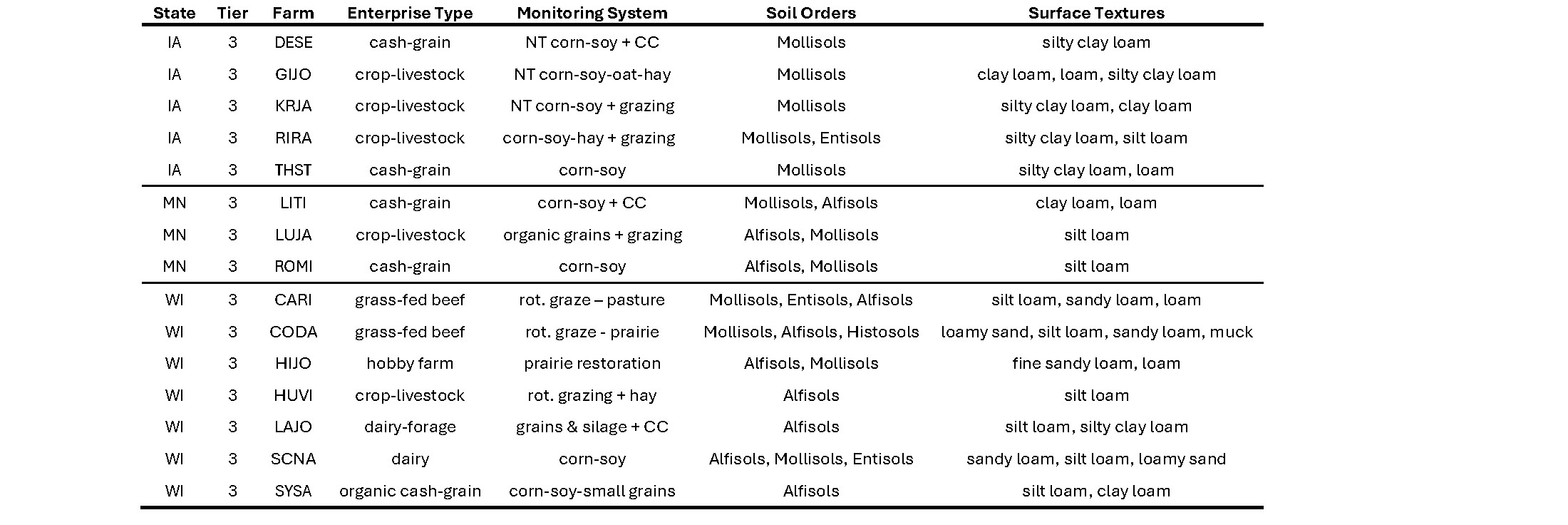
Tier 3: Sample Progress
Target first sampling - Fall 2023
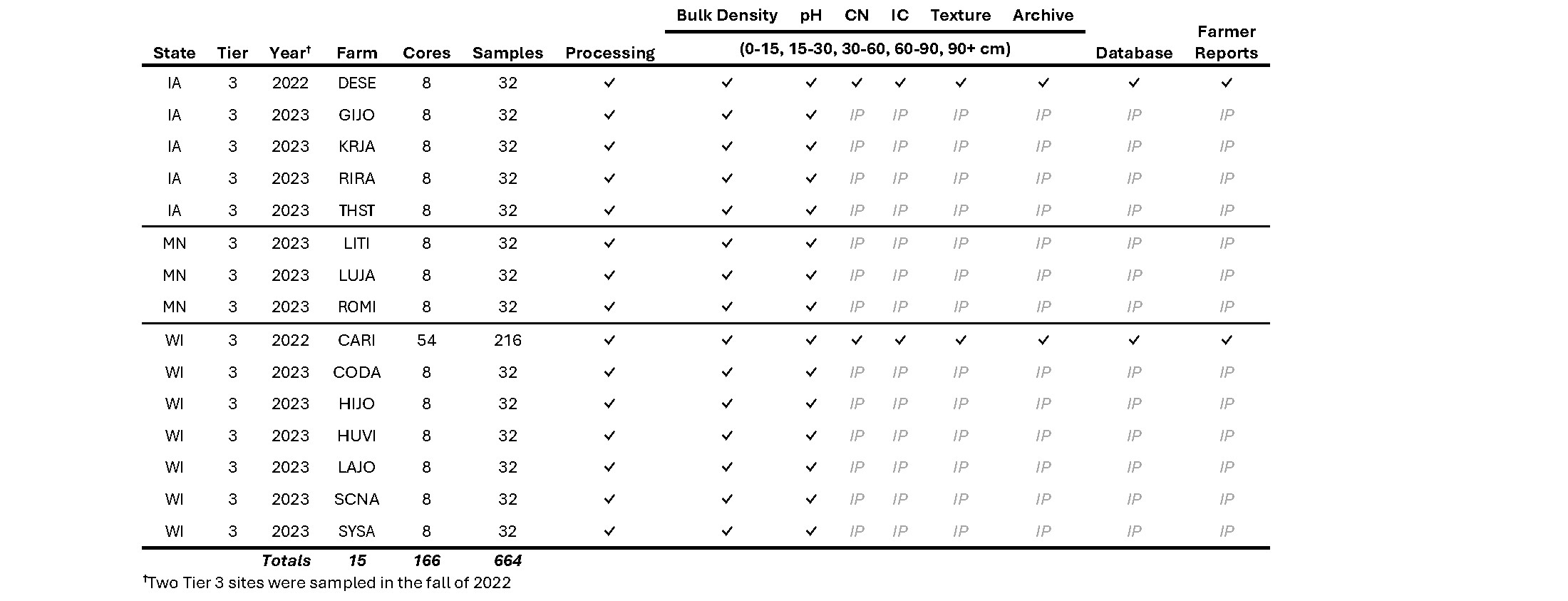
2. Regional on-Farm SOC Stocks: Establishing a Baseline
The first cycle of the SOCnet project is focused on establishing a robust baseline of on-farm SOC stocks. This baseline, established using comprehensive methodologies (whole profile sampling, equivalent soil mass corrections, etc.), will lay the foundation for long-term monitoring of SOC dynamics under agricultural best management practices in Wisconsin, Iowa, and Minnesota. The SOCnet approach is novel in the integration of farmer-led, on-farm experimentation and a commitment to long-term, comprehensive assessment. No other regional network is collecting similarly comprehensive data on deep SOC trends over time. A necessity for accurately predicting "true" SOC dynamics.
2.1 Tier 2: Baseline Data Stats
- Fall 2022 sample collection
- Three states (WI, MN, IA)
- Nine farms
- Three soil orders
- Five soil sub-orders
- Coarse and fine-textured soil
- 152 deep cores (~ 1 m)
- 608 individual samples
2.1.2 Tier 2: Agronomic Fertility
Agronomic fertility is collected at all SOCnet farms and provided to the farmer for use in their own nutrient management planning. Baseline data from the network reveals predictable values for pH, soil test P (Bray-1), and exchangeable K (Bray-1). 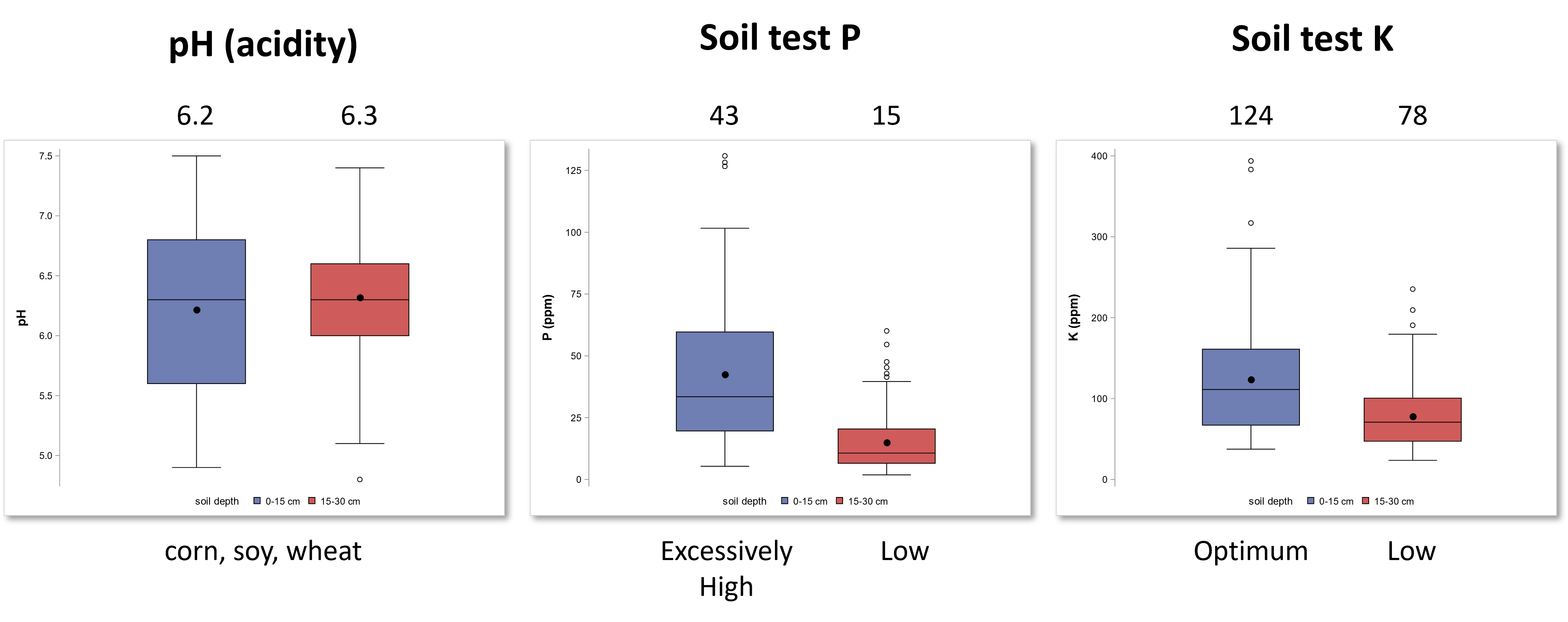
2.1.3 Tier 2: Organic Matter & SOC
Baseline data from Tier 2 reveals the close relationship between total soil carbon (TOC) and organic matter (~ 50% SOC). Early results highlight the relationship across soil orders and soil depth and point to samples that require acid fumigation (high C:N ratio) to remove inorganic carbonates (IC). This step, often omitted in SOC analysis because it is time-consuming and often assumed to be unimportant, is critical to ensure stock assessments reflect SOC (rather than TOC) as IC does not reflect recently accrued C, and agricultural land management has a minimal impact on IC. While IC has been minimal in the SOCnet dataset, we encounter it in certain sites, particularly at depth, where we begin to encounter calcareous glacial till.
2.1.4 Tier 2: Carbon Stocks
Baseline data from Tier 2 reveals the influence of soil order and sampling depth on SOC stocks. We find the highest SOC stock in our prairie-derived Mollisols and the lowest in our forest-derived Alfisols. Entisols, which are often found in flood plains and along streams, are similar to the Alfisols in Tier 2 but exhibit far greater SOC stocks in the deep soil horizons, likely due to high water tables. For the Mollisols and Entisols, stocks in the 30-60 cm horizon are as large or larger than those in the surface horizons. This is due in large part to the sampling depth being twice that of the 0-15, and 0-30 cm soil horizons.
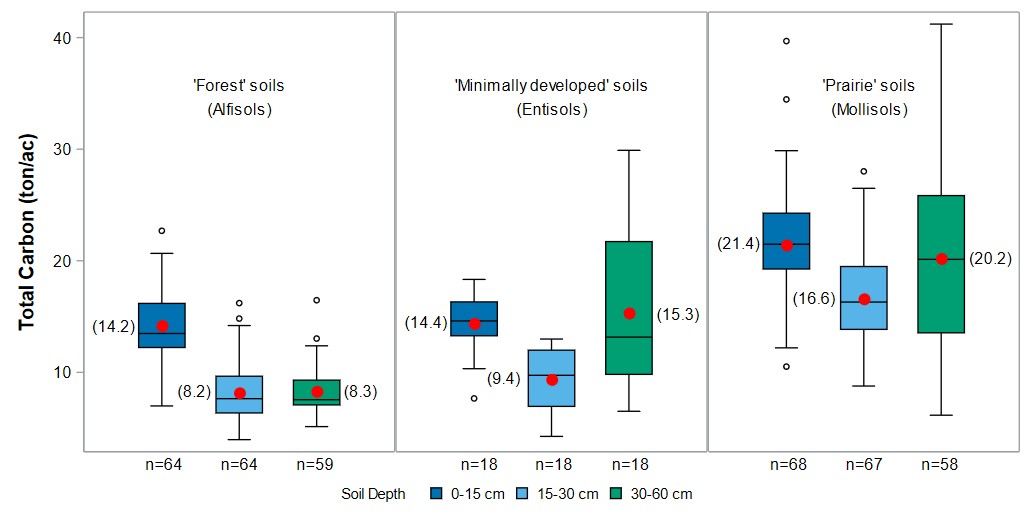
2.1.5 Tier 2: Benefits of SOC Visible in Baseline Data
Assessment of the Tier 2 baseline data highlights the critical importance of SOC in decreasing soil bulk density (alleviating compaction), and increasing cation exchange capacity (nutrient supply & retention)! This data has been particularly compelling in meetings with farmers and illustrates that building on-farm SOC has the potential to enhance productivity, profitability, and resilience.
3. Communicating our Findings
A key object of SOCnet is to "democratize" SOC data. We seek to do this by providing participating farmers with the highest quality SOC and soil health data from their farm operation in a format that is accessible and intelligible. We work with farmers to understand their data through network-wide and one-on-one meetings as needed throughout the year.
3.1 Farm Soil Reports - User Guide
A user guide accompanies all farm soil reports. This guide is intended to help farmers make sense of the data collected on their farm in relation to the broader SOCnet database. 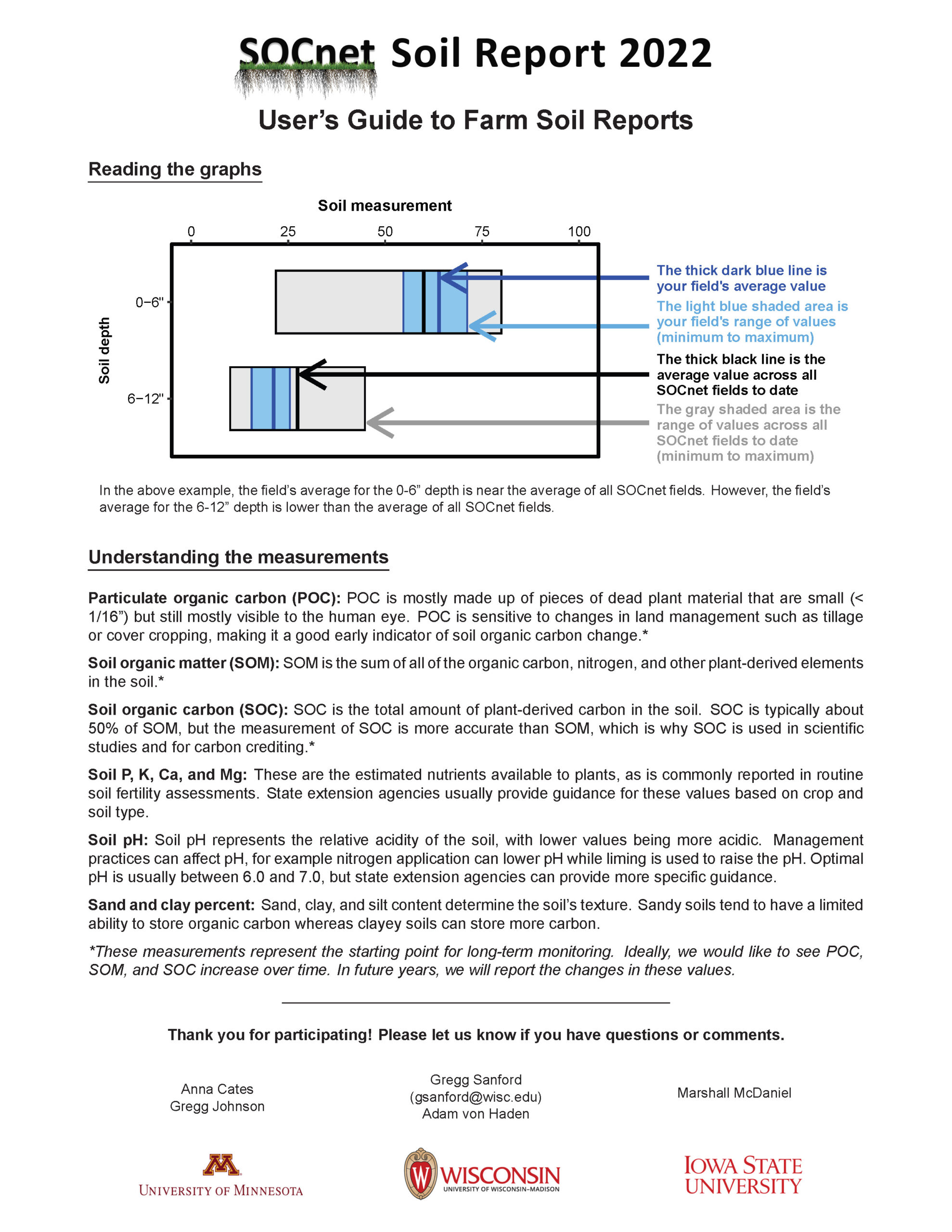
3.2 Farm Soil Reports - Data Guide
A data guide accompanies all farm soil reports. This guide provides technical details about the soil parameters analyzed as part of the SOCnet project.
3.3 Farm Soil Reports - Data Visualization
SOCnet farm soil reports are designed to provide accessible visualizations of each soil parameter sampled. In addition to the visual reports returned to each participating farmer, .csv files of their on-farm data are made available upon request.
SOCnet example report - graphs
3.4 Farm Soil Reports - Tabular Data
In addition to the visual reports, tabular data is returned to each participating farmer. Upon request, participating farmers are also provided with .csv files of their data.
1. Ecological Intensification Key to SOC Stabilization & Accrual
Analysis of the 30 years of data from the Wisconsin Integrated Cropping Systems Trial (WICST - SOCnet Tier 1) emphasized the importance of ecological intensification (e.g., reducing tillage, enhancing living cover, perennials, crop-livestock integration) to stabilize and build SOC in the farming systems of the Northcentral US. In this study, we measured density corrected (ESM) SOC to a depth of 90 cm in six common Midwestern Cropping Systems and a restored prairie. WICST is located at the UW-Madison Arlington Agricultural Research Station in Arlington WI, USA. We found that despite the use of no-till practices and cover crops, cash-grain systems (both organic & non-organic; see "Tier 1: Experimental Hub Overview") lost SOC in both shallow and deep horizons in the 30 years since WICST was established (1989 to 2019). The dairy forage systems in the study (both organic & non-organic) maintained SOC in surface horizons but lost SOC below 15 cm and when the whole 90 cm soi profile was taken into consideration. Grassland systems (rotational grazing and restored prairie) sequestered SOC in the uppermost soil horizons but lost SOC in deeper horizons such that when the whole soil profile was considered, the grassland systems were SOC stable. These high-impact findings were published in Communications Earth & Environment a Nature Portfolio journal. For more details Dietz et al., 2024a and Dietz et al., 2024b.

2. Robust Empirical Methods Underpin Accurate SOC Assessment
2.1 Measurement, Reporting, and Verification (MRV) - Best Practices
As the debate over appropriate methods for Measurement, Reporting, and Verification (MRV) of SOC accrual continues, we have leveraged the SOCnet infrastructure to proactively contribute to the national conversation and promote best practices.
2.2 Paired Resampling Improves ΔSOC Esimates
Bradford et al. (2023) highlighted how spatial variability of SOC stocks is a major obstacle for detecting single-field SOC stock changes when using field sampling schemes common in measurement, reporting, and verification (MRV) protocols. Specifically, when soil sampling is constrained to economically feasible densities (e.g., ~1 sample ha-1), and spatial sampling locations are randomly selected through time, Bradford et al. (2023) showed that single-field estimates of SOC stock change can be highly inaccurate. While sampling density is often limited by logistical and financial constraints, the decision to employ a temporally random versus a paired sampling scheme (i.e., temporal resampling near the original sampling locations) should pose minimal constraints (e.g., it may require a GPS receiver). Bradford et al. (2023) suggested that a paired design theoretically could improve SOC stock change estimates over temporal random sampling and that more research exploring this approach should be undertaken. While we agree that this issue is urgent given a lack of consistency in currently employed MRV protocol sampling schemes (Oldfield et al., 2021), several studies have shown the statistical benefits of paired temporal sampling for estimating temporal changes in soil properties (e.g., Papritz and Webster, 1995; Lark, 2009; Brus and de Gruijter, 2013). Combining an approach analogous to Bradford et al. (2023), a spatially gridded SOC stock dataset from WICST (SOCnet Tier 1), and a spatial autocorrelation model, we visually demonstrate how resampling soils near the original sampling locations mitigates sampling errors associated with temporal random sampling when estimating SOC stock change. For more details, see von Haden et al., 2024.
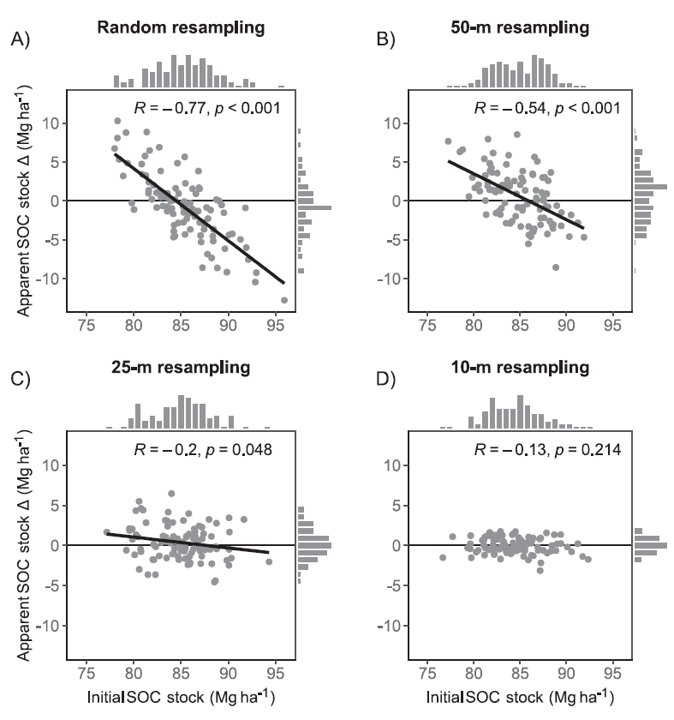
2.3 MRV Minimum Requirements Should Include Equivalent Soil Mass and 60 cm Sampling
As interest in the voluntary soil carbon market surges, carbon registries have been developing new soil carbon measurement, reporting, and verification (MRV) protocols. These protocols are inconsistent in their approaches to measuring soil organic carbon (SOC). Two areas of concern include the type of SOC stock accounting method (fixed-depth (FD) vs. equivalent soil mass (ESM)) and sampling depth requirement. Despite evidence that fixed-depth measurements can result in error because of changes in soil bulk density and that sampling to 30 cm neglects a significant portion of the soil profile’s SOC stock, most MRV protocols do not specify which sampling method to use and only require sampling to 30 cm. Using data from UC Davis’s Century Experiment (“Century”) and UW Madison’s Wisconsin Integrated Cropping Systems Trial (WICST, SOCnet Tier 1), we quantified differences in SOC stock changes estimated by FD and ESM over 20 years, investigating how sampling at-depth (> 30 cm) affected SOC stock change estimates, and estimated how crediting outcomes taking an empirical sampling-only crediting approach differ when stocks are calculated using ESM or FD at different depths. We found that FD and ESM estimates of stock change can differ by over 100 percent and that, as expected, much of this difference is associated with changes in bulk density in surface soils (e.g., r = 0.90 for Century maize treatments). This led to substantial differences in crediting outcomes between ESM and FD-based stocks, although many treatments did not receive credits due to declines in SOC stocks over time. While increased variability of soils at depth makes it challenging to accurately quantify stocks across the profile, sampling to 60 cm can capture changes in bulk density, potential SOC redistribution, and a larger proportion of the overall SOC stock. ESM accounting and sampling to 60 cm (using multiple depth increments) should be considered a minimum best practice when quantifying change in SOC stocks in annual, row crop agroecosystems. For carbon markets, the cost of achieving an accurate estimate of SOC stocks that reflect management impacts on soils at depth should be reflected in the price of carbon credits. For more details, see Raffeld et al., 2024.
2.4 Comprehensive Methods Critical for SOC accounting: Long-term, Whole Profile, Mass Corrected
The SOCnet approach
Sensitivity analysis of SOC changes over 30 years at WICST (SOCnet Tier 1) showed that incomplete methodologies overestimated soil organic carbon improvements. The simulated use of alternative, less comprehensive methods resulted in marked changes to the estimated total ΔSOC1989-2019 of each system (see figure below). These changes were not consistent in magnitude across systems. The space-for-time, shallow sampling, and depth-based methods, compared to the comprehensive results, affected the ΔSOC1989-2019 by ranges of −0.35 to 0.62, 0.08 to 0.58, and −0.10 to 0.16 Mg ha−1 yr−1, respectively. Incomplete methods altered the trends emerging from the data. Using space-for-time, with 2019 MaAA SOC stocks as the baseline rather than 1989 SOC stocks by location, the losses estimated by the comprehensive assessment in Maize, MaAA, and org. Mo/aA were no longer statistically different from zero (a change of 0.62, 0.58, and 0.33 Mg ha−1 yr−1, respectively), and gains in MIRG appeared statistically significant (a change of 0.57 Mg ha−1 yr−1) (Supplementary Information. Table S2). Shallow sampling (0–30 cm) rather than sampling to 90 cm had a positive impact on apparent ΔSOC1989-2019 across systems, with an average increase of 0.33 Mg ha−1 yr−1. It also reduced variation in ΔSOC1989-2019, especially for the perennial systems MIRG and Prairie. The effect of depth-based sampling without ESM corrections was marginal for the cumulative soil profile but more pronounced in the 0–15 cm depth (see figure below), which had experienced greater changes in ρb. Within the 0–15 cm depth, losses in Maize, MS, and org. MSW, as well as gains in MIRG were no longer evident in the depth-based scenario (a change of 0.16, 0.08, 0.12, and −0.02 Mg ha−1 yr−1, respectively). For more details, see Dietz et al., 2024a, and Dietz et al., 2024b.

Education
The project seeks to "democratize" soil organic carbon and soil health data by building a farmer-scientist collaboration. In building the Soil Organic Carbon Network farmers and scientists are engaging in the co-development of on-farm experiments and decision support tools to assess, interpret, and maximize the real-world impact of robust, high quality soil organic carbon and soil health data. Farmers set goals and generate questions that they are keen to reach and answer on their farms. The scientific team then works to collect and interpret long-term, deep, and comprehensive soil organic carbon, soil health, and on-farm managmenet data from the broader network to facilitate on-farm decision making. Regular network meetings will also facilitate peer-to-peer learnign between participating farmers and guide future research directions.
Project Activities
Educational & Outreach Activities
Participation Summary:
The 2024 field season saw a flurry of SOCnet related activity in WI, MN, and IA. The network now includes 26 on-farm locations with 11 in Tier 1 (on-farm experiments) and 15 in Tier 2 (long-term monitoring) as well as 5 long-term experiments in WI (WICST), IA (Marsden), and MN (LTARN). We held several one-on-one meetings with participating farmers, held a network-wide winter meeting, and hosted field days in all three states. We also released our first "batch" of baseline on-farm data from Tier 2 that was incredibly well received by participating farmers and resulted in thought-provoking follow-up discussions with many.
In addition to these farmer-facing activities, we had several opportunities (invited and submitted) to present on SOCnet to academic, agency, and industry colleagues at meetings and conferences.
We continue to look for way to leverage the SOCnet infrastructure for additional funding that can be used to expand and improve the current network. In 2024 we pursued the following opportunities.
Reilly-Baldwin Wisconsin Idea Endowment
- Proposal: Work with SOCnet farmers to develop a "dashboard" that would enable streamlined interaction with SOCnet data and foster self-guided inquiry
- Budget: $120,000
- Duration: 3 years
- Status: not-funded
- Comment: review committee was very supportive of the concept and felt it was likely to be funded via external sources and therefore not a classic fit for the Reilly-Baldwin call
NRCS Cooperative Conservation Agreement
- Proposal: Expand SOCnet in WI to cover dominant agricultural MLRAs as well as major farm enterprise sectors
- Budget: $1,500,000
- Duration: 5 years
- Status: not-funded
- Comment: Contract agreements were progressing and the SOCnet team was under the impression that the project would be funded. Last-minute communications from NRCS put the project on hold indefinitely.
USDA-NIFA-AFRI: Foundational and Applied Science Program
- Proposal: Ecological intensification for soil health, carbon sequestration, and GHG mitigation in cash-grain agroecosystems of the North Central US
- Budget: $750,000
- Duration: 4 years
- Status: funded
- Comment: This funded proposal leverages the ongoing work at SOCnet to investigate the mechanistic drivers underpinning SOC accrual and loss. While not a direct support to the on-farm network, the project does fund SOCnet colleagues (Dr. Cates) at the University of Minnesota.
Project Outcomes
We have had a tremendously successful start to this long-term project. Our on-farm network has grown to a healthy 26 sites and is constrained only by time and money. The interest from producers wanting to participate has been overwhelming. The ongoing dialogue between the scientific team and our farmer collaborators has been enlightening and inspiring!
Information Products
- Soil carbon maintained by perennial grasslands over 30 years but lost in field crop systems in a temperate Mollisol
- Paired resampling to detect field-level soil organic carbon stock change. Comment on “Testing the feasibility of quantifying change in agricultural soil carbon stocks through empirical sampling” by Bradford et al.
- Deep-rooted perennials alter microbial respiration and chemical composition of carbon in density fractions along soil depth profiles
- The importance of accounting method and sampling depth to estimate changes in soil carbon stocks
- Author Correction: Soil carbon maintained by perennial grasslands over 30 years but lost in field crop systems in a temperate Mollisol
- Data from: Soil carbon maintained by perennial grasslands over 30 years but lost in field crop systems in a temperate Mollisol

